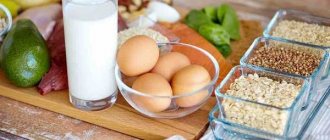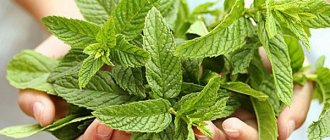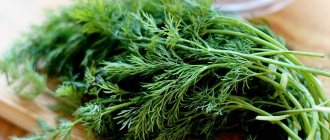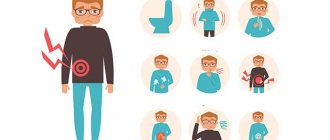General rules
Acidosis means a shift in the acid-base balance to the acidic side.
But this applies to tissues and environments that normally have a neutral environmental reaction of 7-7.35 (blood, tissues, lymph, internal environment of cells). This term does not apply to biological media that are initially acidic (for example, gastric juice) or slightly acidic (urine). To assess the condition of the gastrointestinal tract, the acidity value is determined, which consists of free hydrochloric acid and bound hydrochloric acid. Hydrochloric acid is produced by the parietal cells of the fundic glands of the stomach. A research method that allows you to determine acidity in the stomach and antrum is pH-metry . When performing daily pH measurements, even the daily rhythm of acid formation is determined. This allows for the most effective treatment - prescribing an acid-suppressing drug during the period of highest acidity.
What is dangerous about high stomach acidity? Normally, the process of acid formation is regulated and an increase in acidity turns on the mechanism of acid neutralization: the cells of the antrum of the stomach produce somatostatin , which blocks the secretion of hydrochloric acid. The cause of acid-related diseases is an imbalance in the mechanisms of acid production or acid neutralization, as well as poor nutrition and the presence of constant stress.
Against this background, with insufficient efficiency of the esophageal and pyloric sphincters, pathological gastroesophageal and duodenogastric reflux may occur, manifested by heartburn , belching and bitterness in the mouth. And with an imbalance between aggressive factors (with a high content of hydrochloric acid, pepsin , which represent acid-peptic factors) and protective factors (gastric mucus and duodenum, glycoproteins , bicarbonates , immunoglobulins , reparative activity of the mucosa, its good blood supply), inflammatory phenomena of the gastric mucosa occur . Increased acidity is a frequent companion to gastritis and peptic ulcers .
The secretion of hydrochloric acid and pepsin is regulated by the vagus nerve. And the mechanism of ulcer formation can be represented as follows: increased tone of the parasympathetic nervous system - gastric hypersecretion - formation of an ulcerative defect. Based on this, the opinion “No acid - no ulcer” was supported for a long time, but in recent decades, in connection with the discovery of Helicobacter pylori, the formulation became relevant: “No Helicobacter pylori - no ulcer.”
Therefore, treatment of peptic ulcer is aimed at the effects of two factors - acid-peptic, using drugs that reduce gastric acidity, and Helicobacter. The most powerful drugs that control stomach acid formation are proton pump inhibitors. Antacid drugs are still used, which reduce acidity by interacting with acid in the stomach cavity ( Almagel , Maalox , Taltsid , Rutacid phosphalugel ).
Nutritionists are also taking an approach based on the acidity of the stomach - the diet will depend entirely on this factor. Proper nutrition for high acidity is important, it is part of the healing process and is organized on the basis of Table No. 1 .
The purpose of therapeutic nutrition is to eliminate dyspeptic symptoms (heartburn, nausea, belching, flatulence), pain and improve food digestion. The diet is aimed at reducing gastric excitability and reducing the acid factor. Therefore, strong secretion stimulants (broths, mushrooms, coffee, carbonated drinks, smoked meats, alcohol) and mucosal irritants (condiments, spices, rough foods, rough vegetables, salty, spicy, pickled dishes) are excluded. The gentle regime includes fractional meals, which promotes good digestion and rapid absorption of food.
The degree of sparing and grinding of food depends on the severity of pain and dyspeptic syndromes, therefore the following types of diet can be prescribed:
- No. 1A - with severe exacerbation. It provides for maximum limitation of all effects on the stomach. Dishes are served only boiled, pureed and in a liquid state (slimy soups, porridges, pureed meats, jelly, compotes). Any vegetables and fruits are excluded.
- No. 1B - during the period of improvement. Dishes are also pureed, but their consistency is thicker. Vegetable purees from coarse vegetables, meat and fish soufflé are allowed.
- №1 - this is the main table, which is distinguished by a complete content of proteins, fats (limited animals) and carbohydrates (limited only simple carbohydrates) and moderate sparing of the stomach. It is used during the period of consolidation of treatment results and can be used for constant nutrition of patients.
In all cases, the diet for high stomach acidity involves the exclusion of foods that stimulate gastric secretion:
- meat, fish, mushroom broths, fermented milk products, sour drinks, coarse cereals and vegetables, tough meat with tendons;
- spicy, pickled, smoked and fried dishes;
- coffee, tea and alcohol;
- irritating foods: onions, garlic, peppers, spices, citrus juices, cranberries and other sour fruits and berries, tomatoes, turnips, radishes, ginger, chocolate;
- causing gas formation (legumes, fresh bread and pastries, kvass, drinks with gas, an abundance of sweets) and promoting the reflux of duodenal and gastric contents into the esophagus.
In all types of diet, the amount of animal fats is limited: fatty pork, cream, sour cream, lamb, goose and duck meat. It is not allowed to consume incompatible products that cause fermentation in the gastrointestinal tract.
Dishes are prepared with the addition of vegetable oils and a small amount of high-quality butter. When preparing, steaming, stewing or baking (on the main table) is used. With increased acidity, it is important to follow a meal schedule and not overload the stomach with rich food, especially at night. The last meal is 3 hours before going to bed. Dry food, mono-diet and fasting are excluded. You also need to give up bad habits.
Kefir for gastritis. Can it cause harm?
Even in the chronic stage of the disease, kefir turns out to be very useful. It helps normalize digestion and cleanses the intestines. The disturbed metabolism returns to normal, and the digestive system is again “populated” with beneficial microorganisms.
Digestion of food takes place with maximum efficiency. Vitamins and microelements enter the body in full. This is especially important for pathologies of the gastrointestinal tract. Need to relieve constipation? And here kefir comes to the rescue, which has a mild laxative effect.
Only those people whose acid production is already elevated need to be extremely careful with the drink. Also, kefir is excluded in case of severe heartburn or exacerbations. But low secretion and “fermented milk” are quite compatible things. With daily consumption of kefir, the acidity level will begin to increase. Which in itself is already good - food is absorbed better, gas formation and heaviness in the stomach disappear.
Thus, kefir can harm a patient with gastritis only when the disease is accompanied by excessive secretion of hydrochloric acid in the stomach.
Authorized Products
Nutrition for high stomach acidity includes:
- First courses with weak vegetable broth. Finely chopped vegetables and cereals, vermicelli or thin noodles are added to soups. You can prepare milk soups. It is allowed to add dill in small quantities. The degree of grinding of the ingredients was indicated above.
- Vegetables without coarse fiber (potatoes, pumpkin, beets, carrots, zucchini, green peas, cauliflower). They are prepared as a puree with butter, but without adding spices.
- Lean meat (lean pork, beef, lamb, chicken and turkey) in the form of steamed and baked dishes. Before stewing or baking, meat must be pre-cooked to reduce extractive stimulants. You can cook zrazy, meatballs, cutlets, quenelles, meatballs, aspic, beef stroganoff. Eating protein foods is very important because it helps normalize acidity.
- Well boiled or pureed: buckwheat, semolina, oatmeal or rice porridge without hot seasonings and spices. Porridge can be cooked with the addition of milk, you can also use boiled vermicelli or thin noodles, puddings and casseroles with cereals and cottage cheese.
- Soft-boiled eggs or steam omelet, omelet baked with a little butter.
- Lean, chunky and minced skinless fish, steamed or baked.
- Dairy products - milk, calcined cottage cheese, cream (for adding to soup), milk jelly. Mild cheese, cottage cheese dishes (cheese pancakes, puddings, lazy dumplings).
- Sweet fruits with coarse fiber (bananas, strawberries, pears, cherries, blueberries, apples). During an exacerbation, it is better to exclude fruits, then they are introduced in pureed form (mashed potatoes, jelly, jelly, compotes), and vegetables are consumed in heat-treated form;
- Stale white bread, low-fat biscuits and biscuits.
- Fruit juices, tea with milk, rosehip infusion, weak coffee with milk.
Table of permitted products
| Proteins, g | Fats, g | Carbohydrates, g | Calories, kcal | |
Vegetables and greens | ||||
| zucchini | 0,6 | 0,3 | 4,6 | 24 |
| cauliflower | 2,5 | 0,3 | 5,4 | 30 |
| potato | 2,0 | 0,4 | 18,1 | 80 |
| carrot | 1,3 | 0,1 | 6,9 | 32 |
| beet | 1,5 | 0,1 | 8,8 | 40 |
| pumpkin | 1,3 | 0,3 | 7,7 | 28 |
Fruits | ||||
| apricots | 0,9 | 0,1 | 10,8 | 41 |
| bananas | 1,5 | 0,2 | 21,8 | 95 |
| nectarine | 0,9 | 0,2 | 11,8 | 48 |
| peaches | 0,9 | 0,1 | 11,3 | 46 |
| apples | 0,4 | 0,4 | 9,8 | 47 |
Berries | ||||
| strawberry | 0,8 | 0,4 | 7,5 | 41 |
| raspberries | 0,8 | 0,5 | 8,3 | 46 |
Cereals and porridges | ||||
| buckwheat (kernel) | 12,6 | 3,3 | 62,1 | 313 |
| semolina | 10,3 | 1,0 | 73,3 | 328 |
| cereals | 11,9 | 7,2 | 69,3 | 366 |
| white rice | 6,7 | 0,7 | 78,9 | 344 |
Flour and pasta | ||||
| noodles | 12,0 | 3,7 | 60,1 | 322 |
Bakery products | ||||
| white bread crackers | 11,2 | 1,4 | 72,2 | 331 |
Confectionery | ||||
| jam | 0,3 | 0,2 | 63,0 | 263 |
| jelly | 2,7 | 0,0 | 17,9 | 79 |
| marshmallows | 0,8 | 0,0 | 78,5 | 304 |
| meringues | 2,6 | 20,8 | 60,5 | 440 |
| paste | 0,5 | 0,0 | 80,8 | 310 |
| Maria cookies | 8,7 | 8,8 | 70,9 | 400 |
Raw materials and seasonings | ||||
| honey | 0,8 | 0,0 | 81,5 | 329 |
| sugar | 0,0 | 0,0 | 99,7 | 398 |
| milk sauce | 2,0 | 7,1 | 5,2 | 84 |
Dairy | ||||
| milk | 3,2 | 3,6 | 4,8 | 64 |
| kefir | 3,4 | 2,0 | 4,7 | 51 |
| cream | 2,8 | 20,0 | 3,7 | 205 |
| sour cream | 2,8 | 20,0 | 3,2 | 206 |
| curdled milk | 2,9 | 2,5 | 4,1 | 53 |
Cheeses and cottage cheese | ||||
| cottage cheese | 17,2 | 5,0 | 1,8 | 121 |
Meat products | ||||
| boiled beef | 25,8 | 16,8 | 0,0 | 254 |
| beef liver | 17,4 | 3,1 | 0,0 | 98 |
| boiled beef tongue | 23,9 | 15,0 | 0,0 | 231 |
| boiled veal | 30,7 | 0,9 | 0,0 | 131 |
| rabbit | 21,0 | 8,0 | 0,0 | 156 |
Bird | ||||
| boiled chicken | 25,2 | 7,4 | 0,0 | 170 |
| turkey | 19,2 | 0,7 | 0,0 | 84 |
Eggs | ||||
| chicken eggs | 12,7 | 10,9 | 0,7 | 157 |
Oils and fats | ||||
| butter | 0,5 | 82,5 | 0,8 | 748 |
| ghee | 0,2 | 99,0 | 0,0 | 892 |
Non-alcoholic drinks | ||||
| mineral water | 0,0 | 0,0 | 0,0 | — |
| coffee with milk and sugar | 0,7 | 1,0 | 11,2 | 58 |
| black tea with milk and sugar | 0,7 | 0,8 | 8,2 | 43 |
Juices and compotes | ||||
| apricot juice | 0,9 | 0,1 | 9,0 | 38 |
| carrot juice | 1,1 | 0,1 | 6,4 | 28 |
| pumpkin juice | 0,0 | 0,0 | 9,0 | 38 |
| * data is per 100 g of product | ||||
Causes of high stomach acidity
A nutritious and balanced diet is one of the important components underlying the good health of every person. The habit of following the tenets of a healthy lifestyle helps many people forget about various ailments of their body. But what should someone do if they have some problems with their stomach, in particular, there is a constant or periodic increase in its acidity?
Gastric juice, consisting of hydrochloric acid and special digestive enzymes, is a certain secretion of the gastric mucosa. It is necessary for the primary digestion of food. The acidity level of the secretion is determined by the degree of concentration of hydrogen ions in the composition of hydrochloric acid. The higher the concentration of the latter, the stronger the manifestations of increased stomach acidity.
An increase in the production of hydrogen ions in the gastric mucosa occurs due to:
- unhealthy food abuse;
- addiction to alcohol and smoking;
- congenital anomalies of the stomach;
- infectious organ damage;
- frequent use of certain medications, etc.
With a frequent combination of several of these factors, the risk of developing the disease increases many times over.
Some of the acidic gastric juice enters the esophagus, thereby causing irritation. This occurs due to dysfunction of the smooth muscles of the stomach, which, for various reasons, have lost their ability to contract effectively. At the same time, the gastric mucous membranes are also susceptible to inflammation.
This pathological condition of the stomach in medical science is called gastritis with high acidity, in which the normal digestion process is disrupted. The disease has become extremely common lately. According to medical statistics, almost 50% of the world's population suffers from gastritis of the stomach to one degree or another.
The standard manifestations of this disease should be considered:
- unbearable burning sensation behind the sternum;
- frequent heartburn;
- bitter taste in the mouth;
- sour belching;
- nausea and vomiting;
- pain in the hypochondrium during prolonged fasting;
- loss of taste.
In case of these problems, only a special diet that reduces the acidity of gastric juice will help restore the normal functionality of the stomach.
Fully or partially limited products
Food should not contain:
- Foods with connective tissue (skin, cartilage, veins) as they are digested.
- Rough and irritating vegetables: onions, garlic, radishes, turnips, beans, peas, cabbage, rutabaga, sorrel. Tomatoes due to their high acid content and mushrooms as a difficult to digest product.
- Cabbage soup, borscht, highly extractive broths, okroshka. Fatty fish, fatty pork, goose, duck, canned and smoked meats, lamb, canned fish. Fatty and fried foods stay in the stomach for a long time, which is extremely undesirable with high acidity.
- Millet, barley, pearl barley and corn cereals, thick and coarse pasta.
- Salted, pickled and pickled vegetables, canned vegetables - they all cause an increase in secretion.
- Tomato, meat and mushroom sauce, pepper, horseradish, mustard, mayonnaise, ready-made hot sauces, vinegar.
- Fried and hard boiled eggs.
- Animal fats, margarine, cooking fats for deep-frying.
- Rye and fresh bread, butter and puff pastry products.
- Fermented milk products, sour fruits and berries, chocolate, strong coffee and tea.
Table of prohibited products
| Proteins, g | Fats, g | Carbohydrates, g | Calories, kcal | |
Vegetables and greens | ||||
| vegetables legumes | 9,1 | 1,6 | 27,0 | 168 |
| swede | 1,2 | 0,1 | 7,7 | 37 |
| cabbage | 1,8 | 0,1 | 4,7 | 27 |
| sauerkraut | 1,8 | 0,1 | 4,4 | 19 |
| green onion | 1,3 | 0,0 | 4,6 | 19 |
| bulb onions | 1,4 | 0,0 | 10,4 | 41 |
| cucumbers | 0,8 | 0,1 | 2,8 | 15 |
| canned cucumbers | 2,8 | 0,0 | 1,3 | 16 |
| white radish | 1,4 | 0,0 | 4,1 | 21 |
| turnip | 1,5 | 0,1 | 6,2 | 30 |
| canned tomatoes | 1,1 | 0,1 | 3,5 | 20 |
| horseradish | 3,2 | 0,4 | 10,5 | 56 |
| spinach | 2,9 | 0,3 | 2,0 | 22 |
| sorrel | 1,5 | 0,3 | 2,9 | 19 |
Mushrooms | ||||
| mushrooms | 3,5 | 2,0 | 2,5 | 30 |
Cereals and porridges | ||||
| corn grits | 8,3 | 1,2 | 75,0 | 337 |
| pearl barley | 9,3 | 1,1 | 73,7 | 320 |
| millet cereal | 11,5 | 3,3 | 69,3 | 348 |
| barley grits | 10,4 | 1,3 | 66,3 | 324 |
Confectionery | ||||
| candies | 4,3 | 19,8 | 67,5 | 453 |
| pastry cream | 0,2 | 26,0 | 16,5 | 300 |
Ice cream | ||||
| ice cream | 3,7 | 6,9 | 22,1 | 189 |
Cakes | ||||
| cake | 4,4 | 23,4 | 45,2 | 407 |
Raw materials and seasonings | ||||
| mustard | 5,7 | 6,4 | 22,0 | 162 |
| ginger | 1,8 | 0,8 | 15,8 | 80 |
| ketchup | 1,8 | 1,0 | 22,2 | 93 |
| mayonnaise | 2,4 | 67,0 | 3,9 | 627 |
| ground black pepper | 10,4 | 3,3 | 38,7 | 251 |
| chilli | 2,0 | 0,2 | 9,5 | 40 |
Meat products | ||||
| pork | 16,0 | 21,6 | 0,0 | 259 |
| ham | 22,6 | 20,9 | 0,0 | 279 |
Sausages | ||||
| dry-cured sausage | 24,1 | 38,3 | 1,0 | 455 |
| sausages | 10,1 | 31,6 | 1,9 | 332 |
| sausages | 12,3 | 25,3 | 0,0 | 277 |
Bird | ||||
| smoked chicken | 27,5 | 8,2 | 0,0 | 184 |
| duck | 16,5 | 61,2 | 0,0 | 346 |
| smoked duck | 19,0 | 28,4 | 0,0 | 337 |
| goose | 16,1 | 33,3 | 0,0 | 364 |
Fish and seafood | ||||
| dried fish | 17,5 | 4,6 | 0,0 | 139 |
| smoked fish | 26,8 | 9,9 | 0,0 | 196 |
| canned fish | 17,5 | 2,0 | 0,0 | 88 |
Oils and fats | ||||
| animal fat | 0,0 | 99,7 | 0,0 | 897 |
| cooking fat | 0,0 | 99,7 | 0,0 | 897 |
Non-alcoholic drinks | ||||
| bread kvass | 0,2 | 0,0 | 5,2 | 27 |
| cola | 0,0 | 0,0 | 10,4 | 42 |
| Pepsi | 0,0 | 0,0 | 8,7 | 38 |
| sprite | 0,1 | 0,0 | 7,0 | 29 |
| * data is per 100 g of product | ||||
Symptoms
The acidity of digestive juice can be increased, zero or decreased. Zero acidity in gastric juice is a very serious pathology that requires special attention. With low and zero acidity, the symptoms and principles of nutrition are slightly different than with hypersecretion of gastric juice.
It is possible to accurately determine the level of acidity in the stomach only in laboratory conditions using probing. Even an acid test (a urine test to determine acidity) does not show digital values of indicators.
You should consult a doctor and undergo treatment if necessary.
Typical signs of hypersecretion of gastric juice are:
- burning sensation in the chest area;
- constant heartburn;
- bitter taste in the mouth, loss of taste;
- sour belching;
- nausea, often accompanied by vomiting;
- pain in the hypochondrium;
- frequent bowel movements (constipation, diarrhea);
- sudden weight loss;
- cough - the so-called stomach cough, can be debilitating and often appears with gastrointestinal diseases.
Similar symptoms often occur during pregnancy in women. In this case, you must urgently seek medical help. You must follow a strict diet. If there is no swelling, you can drink non-carbonated mineral water, which helps reduce the acidity level of the stomach.
A diet that reduces high levels of acid in the gastric juice helps restore normal stomach functions. To create a treatment menu, you need to know which foods reduce acidity.
Menu (Power Mode)
During the period of mild exacerbation or recovery, the diet is quite varied, since it includes many vegetables, almost all cereals, meat and fish dishes. Alternating them throughout the week allows you to make your diet varied. Nutrition might look like this.
| Breakfast |
|
| Lunch |
|
| Dinner |
|
| Afternoon snack |
|
| Dinner |
|
| For the night |
|
| Breakfast |
|
| Lunch |
|
| Dinner |
|
| Afternoon snack |
|
| Dinner |
|
| For the night |
|
| Breakfast |
|
| Lunch |
|
| Dinner |
|
| Afternoon snack |
|
| Dinner |
|
| For the night |
|
Sample menu for every day
During a diet with high stomach acidity, the menu for each day may look like this:
- breakfast - oatmeal with low-fat milk, tea with marmalade;
- second breakfast - 2 egg omelet, baked apple with honey, soft dough cookies with milk;
- lunch - cream soup, fresh vegetable salad, boiled potatoes with steamed poultry cutlet, dried fruit compote;
- afternoon snack - cottage cheese with low-fat sour cream, sweet berry jelly with white breadcrumbs;
- dinner - buckwheat porridge with a piece of boiled sea fish, weak tea with marshmallows;
- at night - a glass of fermented baked milk or warm milk.
When compiling a treatment menu, you must use the list of permitted products. In order for the weekly diet to be complete and varied, it is necessary to take equal permitted foods from different groups every day. First courses, side dishes, vegetables, fruits should be changed every day. This principle also applies to meat and fish dishes.
Snacks between main meals can include nuts, berries, and fruits. Preference should be given to sweeter fruits. An excellent fruit against stomach acidity is banana, the daily consumption of which in small quantities will help remove many of the unpleasant symptoms of this stomach disease.
Reviews and results
A diet for high stomach acidity is really necessary and patients note this. Even if it is not strictly observed, but simply excludes foods that cause heartburn and stomach discomfort, it still makes sense. The main table is expanded in terms of products, and this makes it possible to eat a varied diet without particularly infringing on yourself. Reviews from patients indicate the effectiveness of therapeutic nutrition and its positive effect on the intestines and digestion in general.
- “... In spring and autumn, after errors in food, heartburn, belching, and constipation often occur. In such cases, I switch to diet food for 2 months. It helps quickly - heartburn goes away without pills in a week. I eat everything boiled and low-fat, dairy products, cereals and boiled meat, potato, pumpkin and squash puree. I completely exclude coffee and chocolate, soda, cabbage, pickled and pickled vegetables and snacks, and canned food. Of course, steamed cutlets are tasteless without spices, but I can stand it. The stool improves and the heaviness in the stomach disappears. I'm losing a little weight on this diet. The only difficulty I see is that I have to cook separately for myself and take everything with me to work”;
- “... I follow a diet only during periods of exacerbation - and for me it’s spring and after stress. I have long been unable to tolerate onions, garlic, radishes and radishes - first there are pains in the stomach, then colic in the intestines and later heartburn. The same thing with mayonnaise and salads dressed with it - terrible heartburn. It turns out that I naturally excluded them from the diet. I noticed that over the years the list of foods that have to be abandoned due to poor tolerance has become wider and wider. When I switch to medical nutrition, I exclude cabbage and everything connected with it - it is rough and increases pain and bloating. I eat boiled meat and fish, cutlets made from them or meatballs, various cereals and unfried soups. All meat and fish carcasses in water with sour cream are tasty and low-fat. Additionally, I brew chamomile and calendula. Within a week I can already feel an improvement, but I’ve been on a diet for about 2 months. Sometimes you can lose 4 kg”;
- “...I eat irregularly, dry food and often eat fast food. For the last two years I have been experiencing heaviness in the stomach, heartburn and belching. She was examined for gastritis with high acidity and reflux disease. Considering that exacerbations are frequent (but not severe and I am being treated on an outpatient basis), the doctor said that I need to stick to the diet constantly. Sometimes you can expand a little and move away from it, but in general, therapeutic nutrition is assigned to me for the rest of my life. She noted that it helps well. After 2 weeks, all complaints disappear, but I still maintain proper nutrition for about two months. I can’t keep it for a long time because it’s difficult to combine it with work and I don’t have time to cook for myself separately. This is how you gradually get rid of it.”
Benefits and harms
Dairy products are food products made from the milk of animals (cows, sheep, goats, etc.). First of all, these include drinking milk of varying fat content, as well as condensed milk, ice cream, various milk drinks with added sugar, vitamins and other ingredients.
Fermented milk products are food products produced from milk by ripening or fermentation . These include butter, cheese, cottage cheese, kefir, yogurt, fermented baked milk and many other products, including national ones (kumys, ayran, tan, matsoni, kaymak).
Dairy and fermented milk products are valuable food products that contain animal protein, calcium and other microelements, vitamins A, D, E, B1, B2.
Expert opinion
Irina Vasilievna
Practicing gastroenterologist
Milk, dairy and fermented milk products are useful for physical exhaustion, anemia, after illnesses , as well as in cases where “heavy” animal protein (meat, poultry, fish) should be replaced with a “lighter” one.
Not all people can drink natural milk due to lactose intolerance or milk protein allergy. A salvation for them can be fermented milk products, which are not inferior to milk in terms of nutritional value, but are absorbed by the body much better.
In addition, the beneficial bacteria they contain have a beneficial effect on digestion: they improve the digestibility of food, relieve constipation, and help strengthen local and general immunity.
On our website: Kefir for gastritis of the stomach - is it possible or not?
Recipes
Despite the fact that there are a lot of restrictions with gastritis, a person can pamper himself not only with tasty, but also easy-to-follow recipes. Each of the dishes listed below does not take more than half an hour to prepare.
Syrniki
You will need:
- Low-fat cottage cheese – 500 g;
- Wheat flour - 0.5 cups;
- Egg – 1 pc.;
- Sugar – 2 tbsp;
- Vegetable oil – 2 tbsp;
- Salt - to taste.
Add sugar, egg, salt to the cottage cheese, sift the flour and mix well. Grease a baking sheet with oil, place the dough in the form of pies on it (the dough is thick and lends itself well to modeling). Bake for 25 minutes at 180 degrees in the oven. After 25 minutes, the cheesecakes must be turned over and baked for another 5-7 minutes. You can serve cheesecakes with sour cream, sweet berries or honey. An ideal drink would be weak tea or a glass of low-fat kefir. Bon appetit!
Potato and spinach soup
You will need:
- Spinach – 1 bunch (about 350 g);
- Water – 1 liter;
- Potatoes – 1 medium or 2 small;
- Vegetable or olive oil – 2 tbsp;
- Onions – 1 pc.;
- Salt - to taste.
Boil the onion, pre-fried in oil, until golden brown in a saucepan. Salt, add potatoes, wait 10-15 minutes, and then add spinach and leave to simmer under a closed lid for 20 minutes. You can serve it with breadcrumbs and herbs. Bon appetit!
Rice with steamed vegetables
You will need:
- Rice – 3 cups;
- Water – 5.5 glasses;
- Vegetable oil – 2 tbsp;
- Olive oil – 1 tbsp;
- Cauliflower – 1 head;
- Carrots – 1 pc.;
- Spinach – 1 pc.;
- Broccoli – 1 pc.;
- Salt - to taste.
Water is boiled in a double boiler with oil and salt, washed rice is added. Chop the vegetables and add them to the rice and simmer for 30 minutes. Salt to taste, add herbs. Bon appetit!
How does gastritis occur?
The secretion of gastric juice varies throughout the day and depends on food intake. But, logically, the gastric mucosa is constantly exposed to hydrochloric acid, so why does inflammation not develop immediately? Our body is thought out to the smallest detail; protective factors help prevent gastritis. These include mucus, rapid regeneration, motor skills and good blood flow. There are also aggression factors: hydrochloric acid, pepsin, H. Pylori. Under the long-term pressure of bad habits, the “scales break” - the traction force is on the side of the aggressive factors, the protective factors weaken and their quantity is not enough to prevent inflammation and ulceration. It is at this stage that you need to take medications that reduce stomach acidity and go on a special diet.










